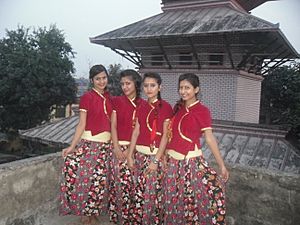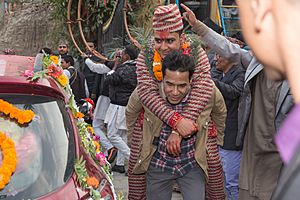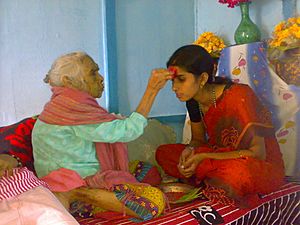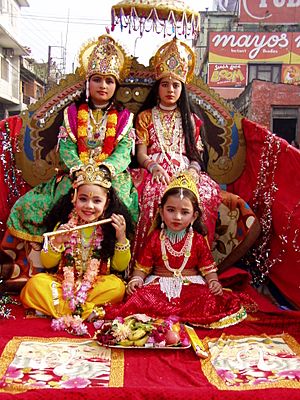Culture of Nepal facts for kids
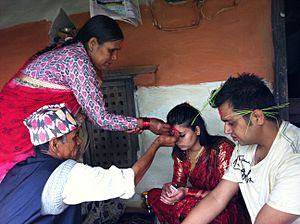
The culture of Nepal is made up of many different traditions from the 125 unique ethnic groups living in Nepal. You can see Nepal's culture in its music and dance, art and crafts, folklore, languages and literature, philosophy and religion, festivals and celebrations, and even its foods and drinks. It's a country rich in diverse customs and ways of life.
Contents
Dance and Music: Rhythms of Nepal
Stories say that dances in Nepal began in the Himalayas, where Lord Shiva performed the tandava dance. This shows that Nepal's dance traditions are very old and special. The style of dances and their costumes change slightly depending on the altitude and the ethnic group.
For example, the Dishka is a dance performed at weddings. It involves fancy footwork and arm movements. The music and instruments also change with the dance's theme. These themes can be about harvesting crops, wedding ceremonies, war stories, or a lonely girl wishing for her love. They often tell stories from everyday village life.
Two famous dances are the Tharu stick dances and the fun peacock dance. There are many other exciting dances too. Often, you might even be invited to join in the dancing as the celebration gets lively!
Languages: A Tapestry of Voices
According to the 2011 census, people in Nepal speak as many as 123 different languages. Most of these languages belong to either the Indo-Aryan or the Tibeto-Burman language families.
The main languages spoken as a mother tongue are:
- Nepali (44.6%)
- Maithili (11.7%)
- Bhojpuri (6%)
- Tharu (5.8%)
- Tamang (5.1%)
- Nepal Bhasa (3.2%)
- Magar (3%)
- Bajjika (3%)
- Doteli (3%)
Nepali is written in the Devanagari script. It is the official national language. It also acts as a common language that helps different ethnic groups in Nepal communicate with each other.
Religions and Beliefs: Spiritual Nepal
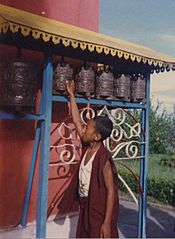
The 2011 census showed that 81.6% of the population in Nepal follows Hinduism. Buddhism is practiced by about 9% of the people. About 4.2% practice Islam, and 3.6% follow the local Kirant religion. Christianity is followed by less than 1.0% of the population.
Hindu and Buddhist traditions in Nepal are very old, going back more than two thousand years. Lumbini is the birthplace of Buddha. The Pashupatinath temple in Kathmandu is a famous old Shiva temple for Hindus. Nepal has many other temples and Buddhist monasteries, along with places of worship for other religions.
Traditionally, Nepali philosophical ideas are deeply connected to Hindu and Buddhist beliefs. These include parts of Kashmir Shaivism, the Nyingma school of Tibetan Buddhism, and tantric traditions. Tantric traditions are very important in Nepal. In some tantric practices, animal sacrifices are performed. Five types of male animals are usually accepted for sacrifice: water buffalo, goats, sheep, chickens, and ducks. Cows are considered very sacred animals and are never sacrificed.
Festivals and Celebrations: Joyful Occasions
Many festivals in Nepal last from one to several days. Since Nepal is mostly a Hindu and Buddhist nation, most festivals are religious. Over 80% of Nepal's population is Hindu, so many festivals come from Hinduism. Buddhism, the second largest religion, also influences Nepal's cultural festivals.
Dashain or Vijaya Dashami is the longest and most important festival in Nepal. It usually happens from late September to mid-October, right after the monsoon season ends. It is known as "a day of Victory over Demons." The Newar people celebrate it as Mohani.
Other widely celebrated festivals in Nepal include Tihar or Dipawali, Holi, Saraswati Puja, Rakshabandhan, Janmashtami, Gai Jatra, Nag Panchami, Teej, Chhath, Kartik Poornima, Maghe Sankranti, Maha Shivratri, and Chhechu. The New Year's Day of the lunar calendar, Nepal Sambat, happens in November. Many Jatras (processions or fairs) also take place throughout the year, and public holidays are declared in some regions.
Other important festivals are Buddha Purnima (which celebrates the birth of Buddha) and Maha Shivaratri (a festival for Lord Shiva). During Maha Shivaratri, some people consume special drinks. Sherpas, who mostly live in higher altitudes and near Mount Everest, celebrate Mani Rimdu for "the good of the world."
Most festivals include dancing and music. A variety of special foods are eaten during festivals and on other important occasions.
The Sagan ceremony is a special ritual. Five food items (a boiled egg, smoked fish, meat, a lentil cake, and rice wine) are given to a person. This is done to bring good luck, according to Tantric tradition.
In Nepal, it is against the law to kill cows. Cows are seen as symbols of motherhood, kindness, and devotion. "Non-violence" is a key idea in Hinduism, Buddhism, and Jainism. When visiting temples, people are asked to take off their shoes to keep the inside clean. Some temples do not allow non-Hindus to enter.
Food habits also differ from region to region. Much of Nepal's food has been influenced by Indian and Tibetan cooking styles. A very popular meal for Nepalis is Thakali, which includes daal (lentil soup) and bhat (rice). Regular Nepali food often includes daal, bhat, tarkari (vegetable curry), and sometimes pickle. Curried meat is also very popular, but some people save it for special occasions. Momos are also a very popular snack among Nepalis. Roti (flatbread) and dhedo (a thick porridge) are also famous dishes in Nepali homes.
Architecture and Archaeology: Ancient Structures

The Nepal Heritage Society has listed 1,262 important architectural and archaeological sites in Nepal. These are located outside the Kathmandu Valley.
Sports: National Games
The government of Nepal has declared volleyball as the national game of the country. Before this, the national game used to be dandi biyo.
The decision to make volleyball the national game was made at a Cabinet meeting. The Ministry of Youth and Sports had suggested this change. The Nepal Volleyball Association had been asking for volleyball to be the national game because it is played in all 75 districts of the country.
Images for kids
-
A procession at a Nepali Hindu Wedding.
See also
 In Spanish: Cultura de Nepal para niños
In Spanish: Cultura de Nepal para niños



